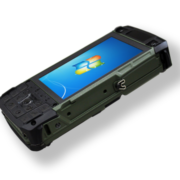Modern computers operate in a “noisy” electronic environment. They are surrounded by powerful electromagnetic interference (EMI) generated by radios, radar, microwave transmitters, other computers, and a wide assortment of electronic equipment. Battlefield computers have to contend with an exceptional level of interference created by military-specific items, such as IED jammers. Of course, EMI protection has grown in importance with the adoption of net-centric warfare doctrine.
They are surrounded by powerful electromagnetic interference (EMI) generated by radios, radar, microwave transmitters, other computers, and a wide assortment of electronic equipment. Battlefield computers have to contend with an exceptional level of interference created by military-specific items, such as IED jammers. Of course, EMI protection has grown in importance with the adoption of net-centric warfare doctrine.
EMI requirements vary widely from one application to another (jeeps vs. airplanes, for instance) and even within an application (above deck and below deck on a Navy ship). MIL-STD 461 incorporates a broad range of requirements for numerous environments. Read more

 dependence on Video Display Terminals. All of us have heard stories of warfighters remotely operating unmanned systems while staring at flickering images on computer monitors. Even manned vehicles are sometimes driven by personnel who use computer screens, so as not to expose themselves to hostile fire. Click
dependence on Video Display Terminals. All of us have heard stories of warfighters remotely operating unmanned systems while staring at flickering images on computer monitors. Even manned vehicles are sometimes driven by personnel who use computer screens, so as not to expose themselves to hostile fire. Click  utilizing the Vista ViCAM® III Application Specific Integrated Circuit (ASIC). This durable, light-weight biometric module makes use of a single-circuit ASIC to support:
utilizing the Vista ViCAM® III Application Specific Integrated Circuit (ASIC). This durable, light-weight biometric module makes use of a single-circuit ASIC to support: small part of the Total Cost of Ownership (TCO). Platform support, customization, integration, connectivity, and inadequate durability may make your “bargain” very expensive. Will your rugged computer be good for your ROI five or ten years from now or just for today?
small part of the Total Cost of Ownership (TCO). Platform support, customization, integration, connectivity, and inadequate durability may make your “bargain” very expensive. Will your rugged computer be good for your ROI five or ten years from now or just for today?


 factors besides nits can interfere with the visibility of a screen. Computer displays are usually protected by see-through shielding material (glass or plastic) on top of their displays. How this shielding is bonded to the underlying surface can have a huge effect on the amount of glare (reflection) that is created. Anti-reflective coating on the shielding material can also affect the overall illumination. Even the mounting of the internal components of the computer can affect the brightness. So, it is theoretically possible that a display with a high nit rating will be dimmer than one that has a lower rating. To be sure you get what you want, consult your computer professional.
factors besides nits can interfere with the visibility of a screen. Computer displays are usually protected by see-through shielding material (glass or plastic) on top of their displays. How this shielding is bonded to the underlying surface can have a huge effect on the amount of glare (reflection) that is created. Anti-reflective coating on the shielding material can also affect the overall illumination. Even the mounting of the internal components of the computer can affect the brightness. So, it is theoretically possible that a display with a high nit rating will be dimmer than one that has a lower rating. To be sure you get what you want, consult your computer professional.